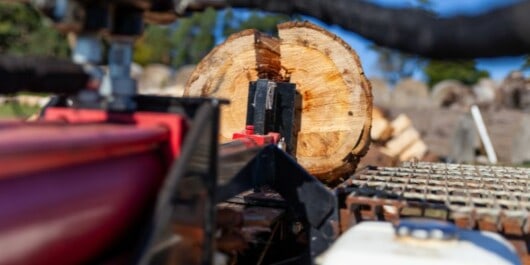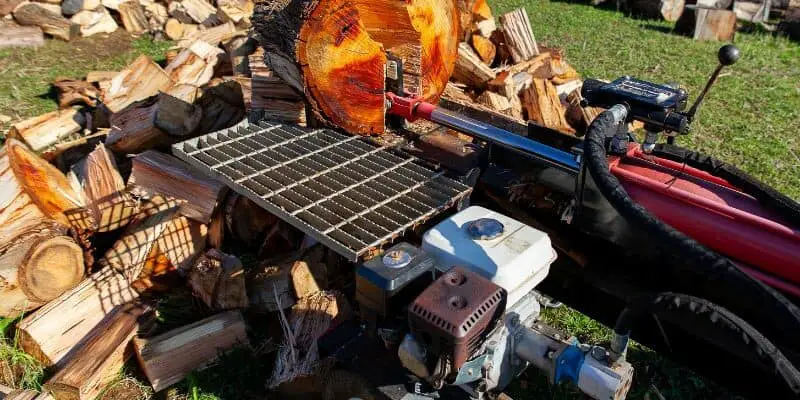Are you a hydraulic log splitter wondering how to do maintenance checks on your machine but don’t know how to? If so, then this blog is just what you need.
Maintenance on a hydraulic log splitter is easy to do as long as you know the right steps. It involves simple steps like inspecting the hoses, using fresh hydraulic fluid to refill it, lubricating the ram, checking the engine, inspecting the pump, and examining the pump chord among other steps. A properly maintained log splitter will help you ensure that you can split wooden log after log safely and efficiently.
In this article, you will get to know all about servicing your log splitter, how to do maintenance on a hydraulic log splitter, indicators that there are issues with your log splitter, and more. Continue reading to get all the answers that you are looking for.
Regular maintenance and service for efficient log splitting
A properly maintained log splitter will allow you to split wooden logs safely and efficiently. The pressure of a log splitter can be hard to beat, but what if you don’t maintain the machine properly? If the hydraulic hoses have worn out, and they start leaking hydraulic fluid, the extreme pressure forcing the fluid through the leak could be enough for splitting the skin from your hand.
Contaminated hydraulic fluid will gradually reduce the efficiency and smoothness of your log splitter. A hydraulic ram that dries out can easily rust and damage the seal surrounding the shaft holding in the hydraulic fluid. Most importantly, loose parts in the pump or engine could cause major failure if they aren’t tightened or repaired straight away. This is why you must know how to service log splitter by yourself.
How to do maintenance on a hydraulic log splitter?
Check the user manual
The first thing that you would have likely done when you bought your log splitter was thrown away the user manual. This is where you went wrong.
The first step here would be to dig out your user manual and read the maintenance instructions for your log splitter. Although the basics are largely the same, most log splitter models come with their own designs and features.
What may be good for the goose might not be good for the gander. This is why you should find the manual and go through it once before continuing.
Inspect the hoses
On your hydraulic log splitter, you will find pipes or hoses running from the reservoir to the ram cylinder. They are the hydraulic pressure poses, and they’ll transfer the fluid from the reservoir to the cylinder for creating pressure.
The pressure created can be numerous tons per square inch. If you’re suspecting that you might have a worn hose that is leaking, you shouldn’t feel around for it. Several tons of pressure leaking through a small hole will be enough to rip open your hand.
Use a playing card or a piece of cardboard and then slowly move it over the area where you are suspecting there could be a leak. The leak would either rip through or discolor the piece of cardboard, so you will know when you have found it. Once you have found the leak, you should replace the hoses straight away.
Use fresh hydraulic fluid
There is a direct correlation between your log splitter’s working power and the hydraulic fluid level. Hydraulic fluid is the main component of your log splitter. You should not let the level get too low, and check it from time to time. To maintain a proper fluid level, you will have to remove the oil filling cap/dipstick, check the oil levels, and fill the oil level as necessary. Moreover, you should ensure that you do this on level ground.
You need to check the hydraulic fluid reservoir for water annually. Water contamination in the hydraulic fluid can build up over time and be identified easily as a milky gray discoloration in the fluid.
This contaminated hydraulic fluid will decrease the log splitter’s efficiency gradually. In fact, it is so gradual that you might not even notice it right away. Over time, it will make for a poorly functioning log splitter. If you’re noticing milky gray contamination in your hydraulic fluid, you should drain it and replace it with new fluid.
Remove air from the hydraulic cylinder
Are you done filling in the hydraulic fluid? You aren’t done yet. You need to bleed or purge the trapped air from the hydraulic cylinder. For doing that, you’ll have to extend the piston rod to its maximum length and then remove the oil filling plug.
Then, you should twist the release screw in a counterclockwise motion as fast as you possibly can. It’ll make the piston rod to draw back into the cylinder, which would then release the trapped air. This step is essential for proper maintenance. When you’re purging the cylinder, make sure that you’re staying clear of the piston rod and use your PPE.
Lubricate the ram
Another important part of your hydraulic log splitter will be the ram. You will have to keep the ram fully greased up. Every square inch of it must be greased, as a dry ram can quickly become a rusty ram.
Rusted rams can damage the hydraulic seal, and you wouldn’t have to damage the seal. If you notice rust forming, you should sand it off, clean it, and then apply more grease.
Check the log splitter’s engine
If your hydraulic log splitter runs on a gas engine, it’ll need to be maintained like any other gas engine. You should check the oil for, ensuring it is clean and full. You should make sure that all the valves and crankshaft are lubricated properly.
Remember to check the carburetor to ensure your engine is running efficiently. Also, remove the spark plug, check the plug gap, and then inspect the condition of the electrodes. A healthy engine will be equally important as a healthy hydraulic system.
Examine the pull cord
You should pull out the cord and inspect its full length for any wear and tear. Cords gradually fray and get weaker with time. The last thing that you’ll want is for the cord to break when you need it. Once you notice significant fraying on the pull cord, you should get yourself a new cord to replace the old one. Once you do that, you will know it is ready to go again when you need it.
Inspect the log splitter pump
The pump in your hydraulic log splitter will be driven by the engine. It generally utilizes a power take-off (PTO) coupling for operating it, so you should check the coupling for loose play.
If you can, you should check the central spindle of the pump to make sure it isn’t getting too loose. If there is too much play to any of these components, it could result in the pump failing when it is under pressure.
While you cannot really tighten these parts, you can still change the bearings. Looseness in the coupling and in the central spindle is usually caused by damaged bearings. This is why you should try replacing them once you notice them getting sloppy.
Sharpen the blades
If you’ve noticed any spots or signs of dullness on the edge of the blade, you should sharpen it via a coarse metal file first. For reforming the sharp point of the blade, make use of a coarse file, as it’ll sharpen the sides. After that, you should finish the process by making use of a file along with the edge of the blade.
Replace any worn-out log splitter parts
Replace the worn parts of your machine as soon as possible. Keeping the components in such conditions will not be a good idea. You should ensure that you compare the component and model number before you purchase new parts. It’ll help you ensure you’re buying the exact part of your log splitter.
This is especially true for the hoses. You should insect them regularly so that there are no kinks or flat areas. If any component is looking worn out or possible puncture, it wouldn’t be worth losing a finger over.
Clean your log splitter regularly
Choose a self-cleaning hydraulic log splitter. If you haven’t got one, make sure that you clean your log splitter regularly. Cleaning the log splitter will involve removing debris, oil, and grease. Moreover, clean the debris around the machine such that nothing gets trapped inside the machine. You should always remember that you turn off the machine before you perform the cleaning work.
A huge part of a clean log splitter will be a clean ram, which means plenty of grease and no rust. Make sure that you’re sanding off any rust and the entire thing is greased properly. This will help elongate the lifespan of the hydraulic seals.

Indicators that there are problems in your log splitter
As you’re running your log splitter, you should listen for excessive vibration or unusual sounds. Vibration is a clear-cut indicator that something is going wrong with your log splitter.
The only sources of excessive vibration in a log splitter are the engine and the hydraulic pump. If you feel or hear your log splitter vibrate excessively, it could indicate that there is an issue with one of the two components.
Lastly, you shouldn’t worry too much about the issues. It is unlikely that you will have many malfunctions to deal with simultaneously. All you have to do is ensure that you stay on top of the maintenance procedure, and your log splitter will last for many, many years.
FAQs
What type of oil to use in a log splitter?
Typically, the log splitter manufacturer will give the recommended oil options within the user manual. However, make sure to have a basic understanding of what to look for. Viscosity is an important concept as higher viscosity will mean a thicker and harder oil to compress, while low viscosity will indicate thinner fluid oil.
Why is maintenance important for your log splitter?
A properly maintained log splitter will help ensure that your machine is working smoothly, and you’re able to keep on splitting wooden log after wooden log seamlessly.
How to store a log splitter?
You will have to store your log splitter in a clean, dry place for preventing damage from water and rust. A garage or shed would be a great choice to store your log splitter.



